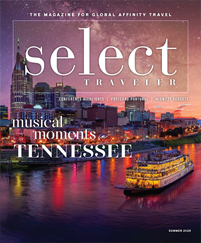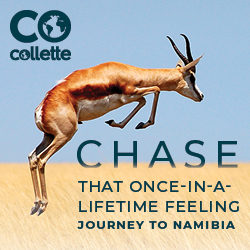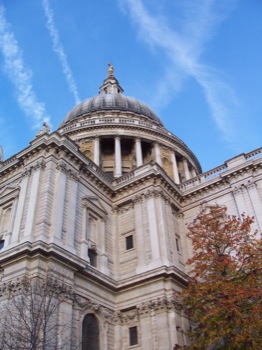
The room is in Kensington Palace in London, where English monarchs lived from the time William and Mary purchased it in 1689 and commissioned architect Christopher Wren to convert it to a royal palace until 1760.
Such surprising contrasts, especially between modern and ancient, are some of the charms and wonders of visiting London, a 400-year-old city that honors and preserves its rich past while being a modern cosmopolitan trendsetter in fashion, arts and architecture.
My wife and I toured Kensington Palace while waiting for our hotel room to be ready during a holiday season visit to London with Globus Family of Brands’ Monograms program.
The convenient hotel location, within sight of the palace and just a block down Bayswater Road from a subway station, was one of the perks of the Monograms program, which combines many of the conveniences of group travel with individualized choices and options. Globus made our air and hotel arrangements, including airport shuttle to and from the hotel, and a Globus representative was in the hotel lobby daily to answer questions, make recommendations or provide assistance, including optional tours.
We availed ourselves of day tours to Bath and Stonehenge in England and to Paris by Eurostar rail through the Chunnel under the English Channel. Otherwise, we were on our own.
Although designed for individual travelers, Monograms would make a great option for bank directors who can’t fill an overseas group trip but have members who would be willing to go on their own.
Hello to the royal family
In addition to its convenient location, Kensington Palace, parts of which are still used by members of the royal family, made a good starting point for the trip as it ties together royal history from the 17th century to the present and provides glimpses into the personal side of the royals.
We entered through a ground-floor exhibit of court wear from the mid-18th century to the present, including several dresses worn by the late Princess Diana, who lived at Kensington Palace.
The impressive King’s Staircase, whose walls and ceilings are covered with paintings by William Kent of life-sized portrayals of life in the court of Charles I, leads to ornate 18th-century public rooms.
The long King’s Gallery looks much as it did when Kent designed it in 1727 to contain the best of the Royal Collection of paintings. A number of large paintings still hang on the rose-colored walls.
The less ornate Queen’s Gallery features some of the many pieces of porcelain collected by Queen Anne, who loved the room.
The tour also includes the bedroom where Queen Victoria slept every night for 18 years in the same room with her mother. It was here where she was awakened early on the morning of June 20, 1837 to be informed that her uncle, King William IV, had died and she was now queen. Her first act was to banish her mother to another room.
The room includes several personal effects of Queen Victoria, including her bed from Buckingham Palace, which she made the official royal residence.
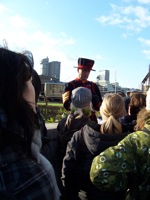 Despite a cool, misty rain, we went for a long morning walk the next day that helped work out the kinks from the flight from Chicago. We headed up Bayswater alongside Kensington Gardens, the former palace grounds that have been a public park since 1841, and Hyde Park, where artists were hanging their wares on its iron fence despite the weather, to the Marble Arch and Speakers’ Corner where Bayswater intersects with Park Lane.
Despite a cool, misty rain, we went for a long morning walk the next day that helped work out the kinks from the flight from Chicago. We headed up Bayswater alongside Kensington Gardens, the former palace grounds that have been a public park since 1841, and Hyde Park, where artists were hanging their wares on its iron fence despite the weather, to the Marble Arch and Speakers’ Corner where Bayswater intersects with Park Lane.
The ornate Marble Arch was designed in 1827 as the main entrance to Buckingham Palace but it was too marrow for the largest coaches and was moved to its present location in 1851.
We were disappointed that no one was out yet at Speakers’ Corner, the distinctly quirky London tradition where anyone, and especially it seems, eccentrics, can hold forth on any topic, often to the heckling of onlookers.
After a coffee break, we strolled down trendy Park Lane, with its expensive auto dealers and hotels where celebrities often stay, to Knightsbridge and the main gate of Hyde Park by Buckingham Palace and from there to the Victoria and Albert Museum.
After a lunch of pork pies in the museum’s cafe, we headed into its massive complex of 145 galleries, which stretches for 7.5 miles. With one of the world’s largest collections of art and design, the Victoria and Albert, known locally as the V&A, has period rooms, fashions covering more than 400 years of European design, silver, large collections of Renaissance sculpture and Indian art and cutting-edge furniture design.
Because of its size, you need to have a game plan for visiting the museum. We decided to focus on the British Galleries, which cover 400 years of British design and fashion, where we saw such fascinating items as Henry VIII’s writing desk and James II’s wedding suit.
If your interest lies more in science or natural history, the Natural History Museum and the Science Museum are in equally massive buildings adjacent and across the street from the V&A.
A popular prince
On our way back to the hotel, we stopped to admire the elaborate and grandiose memorial on the edge of Kensington Gardens to Prince Albert, Queen Victoria’s husband who died in 1861 at the age of 41.
The centerpiece of the 175-foot-tall memorial is a larger-than-life gilded statue of Albert, which is topped by a black-and-gilded spire and multicolored marble canopy and surrounded by nearly 200 sculpted figures.
“There are more things named for Albert than anyone else,” said Carlotta, our guide on a city tour the next day as we passed the memorial. “Victoria made sure you never forgot him. She did love her Albert.”
The half-day city tour was part of the Monogram program, along with a one-day pass on the subway, known as the underground or tube in London, and tickets to the city’s 21st-century icon, the London Eye, a 443-foot-tall observation wheel near the River Thames that gently carries 32 egg-shaped passenger capsules on a 30-minute ride for a sweeping view of London.
The tour, which picked us up at our hotel, provided a good orientation for our later explorations of the city.
Although London is a sprawling metropolis composed of two cities — London and Westminster — and 31 boroughs, it is easy to get around. Much of the city is readily walked, with many of its major tourist attractions in a compact area, and the subway and the famous double-decker red buses and formerly all black taxis make getting around the city convenient.
That being said, be warned that traffic is always heavy, which can run up a taxi fare, which is measured in time as well as distance. Also, even though we were there in off-season, the tube seemed to always be crowded. London has 12 underground lines, and most of the time you will need to make connections, which can involve walking through tunnels and up and down stairs.
The city tour included a stop at St. Paul’s Cathedral and the changing of the guard at Buckingham Palace.
St. Paul’s iconic 360-foot-high dome, the second largest in the world after St. Peter’s in Rome, became a symbol of British resolve and resistance during World War II when it survived German bombing despite the cathedral itself being hit numerous times, including 28 times in one day.
This year marks the 300th anniversary of the cathedral, which was designed by Wren following the Great Fire of 1666. A plaque marking his tomb in the cathedral’s crypt says” “Reader, if you see his monument, look around you.”
Although constrained in his design by conservative church officials, Wren still was able to build a large and ornate edifice. “Everything you see that looks like gold is gold,” said Carlotta, “23.4-karat gold leaf.”
Also among the 114 people buried in the crypt are Lord Nelson and the Duke of Wellington, whose tomb is surrounded by battle flags from Waterloo.
A stained-glass window with the seals of U.S. states in the cathedral honors American World War II dead. In front of the window is a roll of honor book that lists American soldiers stationed in England who were killed during the war. One page is turned each day before the evening service.
Guarding the queen
The Foot Guards of the Household Division of the Army, the queen’s personal guard, stage their formal changing of shifts at Buckingham Palace at midday, with the new guard leaving Wellington Barracks at precisely 11:27 a.m. and marching to the palace, usually accompanied by a band and mounted escorts.
It is an entertaining bit of pomp and circumstance that takes place daily from May to July and on alternate days other times of the year. There is no ceremony if it rains.
After lunch at the Black Lion, a delightful typical British pub we discovered near the hotel, we took the tube back downtown and walked through Leicester Square, Picadilly Circus and Trafalgar Square with its tall monument to Lord Nelson, and toured the National Gallery, which fronts Trafalgar Square.
Like many London museums, the National Gallery is far too large to explore in one visit. Most of its 2,300 paintings are on permanent display and range from the 13th century to 19th-century Impressionists. Most of the collection of British painters is at the Tate Britain across the River Thames.
You need a shopping game plan for Harrods, the gigantic 160-year-old London department store where we stopped on the way back to the hotel to buy some Christmas gifts.
“You can live and die at Harrods,” said Carlotta, noting the wide range of items in the massive store, which has more than 300 departments and 23 restaurants. At night, the building is outlined in 11,000 lights. “It looks like a big Christmas tree,” she said.
The next day it was time for another massive church, Westminster Abbey, where there has been daily worship for 1,000 years. There is one minute of quiet prayer each hour, when everything stops.
“It is a living church with such an extraordinary historic connection,” noted John Hall, dean of Westminster, on our self-guided audio tour.
The abbey’s 102-foot-high nave, which is 35 feet wide, took 150 years to build, and the abbey is a blend of architectural styles. Just as impressive is the history that is associated with the abbey.
Every monarch since William the Conqueror has been crowned there and many are buried within its walls, including Elizabeth I and her sister, “Bloody” Mary I, who is buried beneath Elizabeth in the same crypt.
Many other famous Englishmen and women are also buried in Westminster Abbey, including more than 40 literary figures in Poet’s Corner, beginning with Geoffrey Chaucer in 1400.
“They are packed in like sardines,” said Carlotta.
The abbey’s museum features effigies from the funerals of kings and queens and replicas of coronation items. Britain’s Grave of the Unknown Warrior is in the floor surrounded by red roses as you leave.
That’s old
We weren’t through with large museums, either. That afternoon we headed to the British Museum, the oldest public museum in the world, established in 1753, a sprawling complex with more than 90 galleries and 2.5 miles of halls.
We focused on the Egyptian, Greek and early Briton areas, checking out the Rosetta Stone, the Eglin Sculptures from the Parthenon and the Sutton Hoo ship, a 7th-century Anglo-Saxon king’s burial ship with several recovered artifacts.
Our final day in London started at the Tower of London, a sprawling complex of buildings where the Crown Jewels are kept. Although originally built as a royal residence, the Tower became most famous as a prison.
“It was the first building of its type to be built in England,” said Alan, the head Beefeater who gave us a tour. “Every single building was used at some time to house prisoners.”
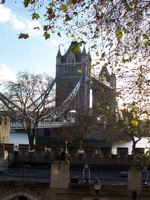 The Beefeaters, or more properly the Yeoman Warders, act as combination guards, tour guides and congenial public relations representatives for the Tower in their distinctive black-and-red outfits.
The Beefeaters, or more properly the Yeoman Warders, act as combination guards, tour guides and congenial public relations representatives for the Tower in their distinctive black-and-red outfits.
The Beefeaters — Alan explained no one knows for sure where the nickname came from — are career master sergeants in the Army and live at the Tower with their families. They have their own doctor, chaplain and pub.
There are several towers and buildings in the complex, from a restored 13th-century room to stark structures with graffiti on the walls that demonstrate how the majority of prisoners were kept.
Two of Henry VIII’s wives, Anne Boleyn and Catherine Howard, were executed at the Tower, as was Sir Thomas More. When Queen Victoria ordered the 1519 chapel at the Tower, which had fallen into disrepair, be restored in the 1870s, the remains of more than 1,500 people were found, including those of Boleyn and Howard, who are now buried in front of the altar, the final stop on the tour.
Another responsibility of the Beefeaters is to tend to the famous Tower ravens that wander around the grounds. Legend has it that Charles II said that if the ravens ever left the Tower, the kingdom and fortress would fail. To make sure that doesn’t happen, the ravens’ wings are clipped so they can’t fly.
Our final stop was a fascinating look at more current history at the Churchill Museum and War Cabinet Rooms. Located in the basement of a government office building near Parliament, the rooms are just as they were during World War II when Prime Minister Winston Churchill, his cabinet and staff worked there during the bombing of London.
The cabinet room is displayed as it look shortly before an afternoon meeting, complete with Churchill’s actual chair. The small room he used, largely for naps, has all original furniture. There is a cigar on his nightstand and the walls are covered with the maps he used to trace the progress of the war.
An adjacent museum, opened in 2005 by Queen Elizabeth II, has many artifacts from Churchill’s life, including his breakfast bed table, uniforms, pistol from the Boer War and the jacket, blazer and hat he wore at the signing of the Atlantic Charter.
A row of photos trigger excerpts from Churchill speeches. In one, he tells how he was such a successful orator. “It isn’t really as difficult as you think,” he said. “I just start my mouth off talking and leave it.”
Monograms
Globus Family of Brands
(800) 250-7614
www.monogramstravel.com
www.globusfamilygroups.com
A Weighty Mystery |
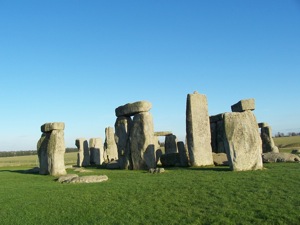 They have been abused over thousands of years by weather, locals looking for building materials for houses and roads, and the curious hands of visitors. But the strange stone pillars and lentils of Stonehenge remain one of Great Britain’s most iconic and mysterious attractions. The site seemed smaller than I expected when we first arrived at Stonehenge on a bright but brisk winter day. However, I was soon mesmerized by the unusual arrangement of stones that can accurately predict the summer solstice and by the fact that the stones, each of which weigh several tons, were quarried, moved a long distance and erected without modern machinery. It is thought that only about half of the original site remains. Stonehenge was part of a day-trip that was an extra-cost option of our Globus Monograms London package. The trip also included a late afternoon stop in Bath, the mineral springs resort favored by health seekers since Roman times. The ruins of the extensive Roman baths, discovered by accident in the 1880s during restoration work on an 18th-century building, are fascinating, especially when lit by torchlight in early dusk with steam rising into the night sky. “The Romans bathed in them, entertained in them, gambled in them, worshiped in them,” said our guide. An informative and well-done audio tour leads through the baths and a museum next to the Bath Abbey. Bath became an 18th-century aristocratic hot spot after Queen Anne discovered its soothing sulfurous waters in 1702. A “mother lode” of Georgian stone buildings remain from that time, making Bath a charming village to explore on foot. We happen to be there during the annual Bath Christmas Market, when the downtown area around the baths and abbey is filled with small, colorfully decorated chalets selling local and handmade items from toys, clothing and house wares to food such as traditional sausage cobs, mince pies and mulled wine. A large Victorian carousel fills one of the squares. |




